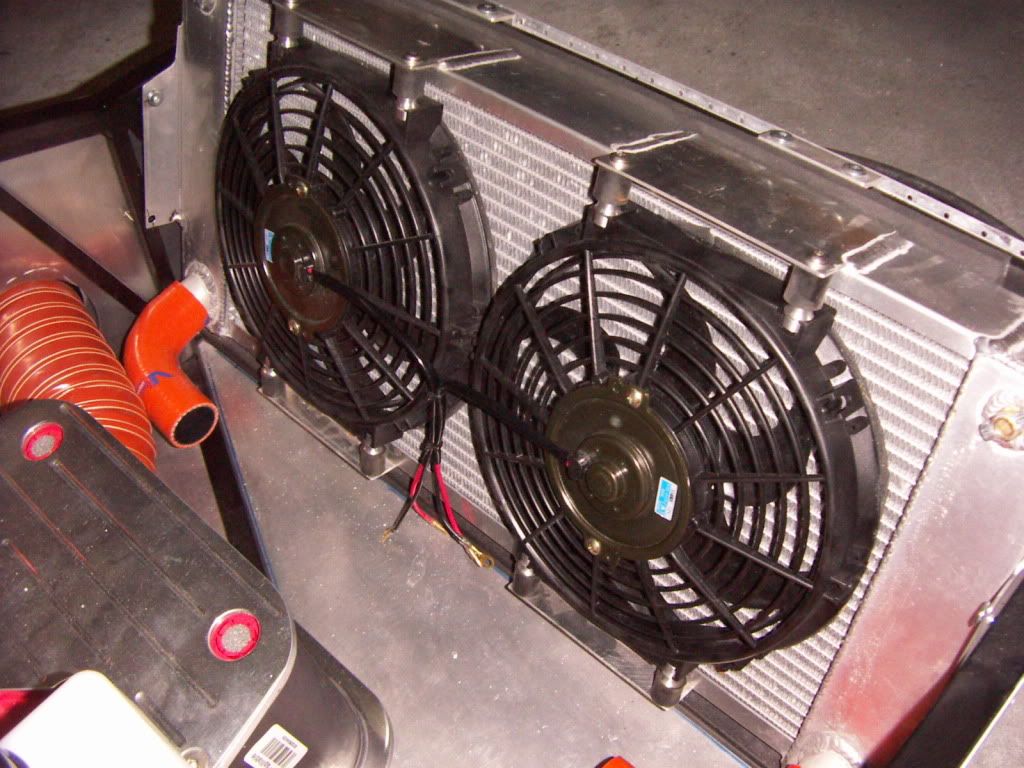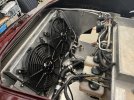This is the radiator supplied with my RCR-40 #45.
It's a very nice single-pass radiator with two rows (very wide) of tubes that is reported to have ample capacity to cool a 600 HP engine.
Rather than just hanging the fans behind the radiator - I wanted to create a shroud to increase the efficiency of the fans.
The only "complaint" I have for this radiator is one that I have for literally any specialty radiator manufacturer::
Why in the world don't you make a radiator with provisions for mounting fans / shrouds?
In this case, there is a very narrow 3/8" lip at the top and a 2" wide lip at the bottom.
The top lip has about 1/4" of air-space underneath until the fins are encountered.
The bottom lip is the same - but there is a LOT more usable space of 1-5/8" wide at the bottom for which there are no fins/tubes directly underneath.


The mounting lips are well below the plain of the side tanks - about 1/4". I needed to do a couple of things here;
1) Build up the mounting lip surface to the same as that of the side tanks
2) Create a reliable surface to bolt the shroud to.
I used 1/4" thick x 1" wide aluminum for the bottom filler (you can see it in the top picture).
The top filler was made from similar material that was 3/8" wide.
Both filler panels were drilled and countersunk so the pop-rivets holding the fillers in place would not sit proud of the surfaces.
The shroud was made from 6160 T6 .080".

Retaining the fans::
The fans are drilled for 1/8" rivets as well as numerous radial mounts that are meant for 6mm bolts/nuts. I don't feel that rivets alone are sufficient to retain the fans so I opted to use 1 x 1 Angle aluminum (1/8" thick) to create a mounting ledge for the 1/4" bolts to mount the fans at the bottom/top. Note that I did not have any 6mm so I ground the heads on 1/4" bolts down to fit in the retaining slots.


The Top Plate is something rather special to me. It is a piece that I bought from an Auction at Richard Childress Racing about 10 years ago. It is an old radiator top mounting plate from one of Dale Earnhardt's Chevrolet Luminas.
Yes - I am also a NASCAR fan - please don't shoot me...



It's a very nice single-pass radiator with two rows (very wide) of tubes that is reported to have ample capacity to cool a 600 HP engine.
Rather than just hanging the fans behind the radiator - I wanted to create a shroud to increase the efficiency of the fans.
The only "complaint" I have for this radiator is one that I have for literally any specialty radiator manufacturer::
Why in the world don't you make a radiator with provisions for mounting fans / shrouds?
In this case, there is a very narrow 3/8" lip at the top and a 2" wide lip at the bottom.
The top lip has about 1/4" of air-space underneath until the fins are encountered.
The bottom lip is the same - but there is a LOT more usable space of 1-5/8" wide at the bottom for which there are no fins/tubes directly underneath.


The mounting lips are well below the plain of the side tanks - about 1/4". I needed to do a couple of things here;
1) Build up the mounting lip surface to the same as that of the side tanks
2) Create a reliable surface to bolt the shroud to.
I used 1/4" thick x 1" wide aluminum for the bottom filler (you can see it in the top picture).
The top filler was made from similar material that was 3/8" wide.
Both filler panels were drilled and countersunk so the pop-rivets holding the fillers in place would not sit proud of the surfaces.
The shroud was made from 6160 T6 .080".

Retaining the fans::
The fans are drilled for 1/8" rivets as well as numerous radial mounts that are meant for 6mm bolts/nuts. I don't feel that rivets alone are sufficient to retain the fans so I opted to use 1 x 1 Angle aluminum (1/8" thick) to create a mounting ledge for the 1/4" bolts to mount the fans at the bottom/top. Note that I did not have any 6mm so I ground the heads on 1/4" bolts down to fit in the retaining slots.


The Top Plate is something rather special to me. It is a piece that I bought from an Auction at Richard Childress Racing about 10 years ago. It is an old radiator top mounting plate from one of Dale Earnhardt's Chevrolet Luminas.
Yes - I am also a NASCAR fan - please don't shoot me...



Last edited:







